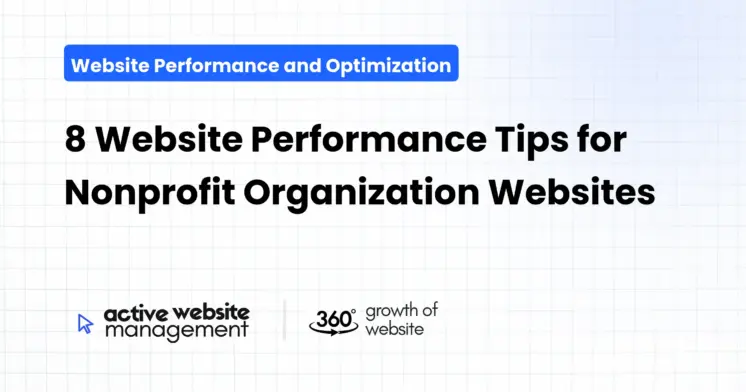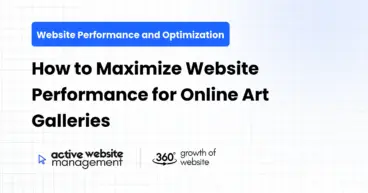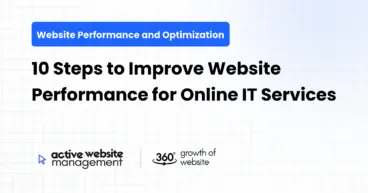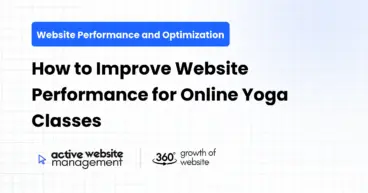February 3, 2025
14 min read
Nonprofit organizations rely heavily on their websites to achieve their missions. A slow, clunky website can turn away potential donors, volunteers, and beneficiaries. In today’s fast-paced digital world, website performance is paramount. This article will equip you with eight actionable tips to ensure your nonprofit’s website is not only impactful but also lightning-fast and user-friendly. We’ll cover everything from the “why” behind performance optimization to the “how” with practical examples, ensuring you have the tools to make a real difference. We will focus on keywords like nonprofit site speed, charity website optimization, and fundraising platform performance to help you understand what steps to take to improve your site.
1. Prioritize Speed: The Foundation of a Good Website
Why Speed Matters for Nonprofits
Imagine a potential donor landing on your website, ready to make a contribution, but the page takes an eternity to load. Frustration sets in, and they might just click away, perhaps to a competitor. This scenario illustrates a critical truth: site speed directly affects user engagement. A fast website keeps visitors on the page longer, encouraging them to explore your content, learn about your cause, and ultimately, take action. This is crucial for charity website optimization. When your page loads faster, it helps reduce user frustration and keeps their attention focused on your message, ultimately driving your donation, sign up and engagement rate.
Understanding Core Web Vitals
Google, the gatekeeper of the internet, has made it clear that website speed is essential. Their Core Web Vitals—Largest Contentful Paint (LCP), First Input Delay (FID), and Cumulative Layout Shift (CLS)—are the metrics used to gauge user experience.
- Largest Contentful Paint (LCP): Measures how long it takes for the largest piece of content (like an image or text block) to load. A good LCP score is under 2.5 seconds. The faster the load speed, the better the user experience will be.
- First Input Delay (FID): Measures the time from a user’s first interaction (like clicking a button) to the browser’s response. Aim for an FID under 100 milliseconds. This measurement focuses on how fast the website responds to user action which can improve user engagement by a huge rate.
- Cumulative Layout Shift (CLS): Measures how much elements shift around unexpectedly while the page is loading. This can be very frustrating for the user if content shifts once they are about to click on a button. A good CLS score is under 0.1.
Don’t Just Maintain Your Website—
Grow It using Active Website Management! Don't Wait for Growth—Accelerate It with Active Website Management
Practical Steps to Boost Speed
- Image Optimization: Large, uncompressed images are a major culprit for slow websites. Tools like TinyPNG or ImageOptim can drastically reduce file sizes without compromising visual quality. Always save your images in the optimal format (JPEG for photos, PNG for graphics, WebP for best overall compression if supported by your user’s browser). This is a crucial aspect of nonprofit site speed.
- Leverage Browser Caching: Enabling browser caching allows repeat visitors to load your website faster by storing some of the website’s resources directly in their browser. This is a fairly easy step to implement and will improve your users’ experience.
- Minify CSS, JavaScript, and HTML: Minification removes unnecessary characters (spaces, line breaks) from your code, making the files smaller and faster to load. There are many free online tools that can do this, or your developer can implement it on the site.
- Choose a Fast Web Host: A cheap, slow web host can sabotage all your other optimization efforts. Research hosting providers known for performance and fast servers. There are numerous web hosting options for non profits that are affordable and are equipped with high-speed servers for optimal performance.
- Use a Content Delivery Network (CDN): CDNs store copies of your website on servers located around the world. This means that visitors from different locations can access your content from a server closer to them, resulting in faster loading times.
2. Mobile-First Approach: Reach Donors on the Go
Why Mobile Matters
The majority of internet users today browse on their mobile devices. For nonprofits, this means your website must be just as user-friendly on a smartphone as it is on a desktop. A website that is not optimized for mobile will likely lose donors, sign-ups, and advocates because of the frustrating experience it offers. Failing to address this will hamper your efforts to increase your organization’s reach.
Responsive Design
Responsive design is the solution. This ensures that your website automatically adapts to the screen size of the device being used. This is a crucial element for any fundraising platform performance, as your mobile users could be making donations on the go.
- Fluid Layouts: Ensure your website layout adjusts to different screen sizes without compromising the content or visual appeal.
- Clear Typography: Use fonts and text sizes that are easy to read on smaller screens, maintaining accessibility for all users.
- Touch-Friendly Navigation: Buttons and menus should be large enough and well-spaced to avoid accidental clicks on mobile devices.
- Image Optimization (Again!): Mobile users often have slower internet connections. Optimize images to load quickly on mobile devices, as well.
- Mobile-First Content: Prioritize the most important information for mobile users, as they tend to be looking for specific pieces of content.
Testing on Different Devices
Regularly test your website on various devices and browsers to catch any mobile usability issues. There are a number of tools that can test your website responsiveness across a myriad of devices. There may also be slight variations between device types, so it is best to check as often as possible.
3. Simplified Navigation: Lead Users to Your Goals
The Importance of Clear Navigation
Users should be able to find what they need quickly and easily on your site. A confusing navigation structure is a recipe for high bounce rates. Your website should be intuitive to your user by providing clear calls to action that are easy to identify.
Best Practices for Website Navigation
- Keep it Simple: Use clear and concise labels for your menu items. Avoid jargon or overly complex terms. If necessary, add a “what we do” section that clearly describes your organization’s mission.
- Use a Logical Hierarchy: Group related content under logical headings. This ensures that users can navigate to the section they need easily.
- Prominent Search Bar: A search bar is crucial for users who are looking for something specific, and can help them skip to what they are looking for instead of having to search through your menus.
- Sticky Navigation: A sticky navigation menu (one that stays at the top of the page as the user scrolls) makes it easy to access key areas of your site from anywhere on the page.
- Clear Call-to-Action (CTA) Buttons: Use strategically placed CTAs like “Donate Now,” “Volunteer,” or “Sign Up” to guide users toward your organization’s goals.
Let’s say your current menu looks like this:
- “About Us”
- “Our Programs”
- “Get Involved”
- “Donate”
- “Contact Us”
- “Volunteer Opportunities”
- “Financials and Reports”
This could be improved for clarity:
- “About”
- “Who We Are”
- “Financials and Reports”
- “Our Work”
- “Get Involved”
- “Contact”
This revised menu is clearer and more user-friendly, grouping related topics and simplifying the number of items.
Don't Wait for Growth—Accelerate It with
Active Website Management Don't Wait for Growth—Accelerate It with Active Website Management
4. Content Optimization: Engage, Educate, and Inspire
The Power of Relevant Content
Content is king, especially for nonprofits. Your website should clearly communicate your organization’s mission, impact, and values. It should also tell an engaging story of the work that your organization does. Relevant content will keep your user’s attention on the site and also help your site improve its search engine rank by incorporating targeted keywords.
Creating Compelling Content
- Storytelling: Share personal stories and impact reports to show how your organization is making a difference. Humanize the impact that you have and show real people who have been impacted.
- Blog Posts: Write insightful articles related to your cause, sharing news, updates, and engaging content. This is great for improving your site’s search engine optimization, as well.
- Multimedia: Use videos, photos, and infographics to communicate your message more effectively. These elements are generally more engaging than just text.
- Clear and Concise Language: Avoid jargon and technical language. Use simple and engaging words that are easy for everyone to understand.
- Regular Updates: Keep your content fresh and up-to-date. This shows your audience that your website is active and that your organization is still working.
- Keywords: Use keywords naturally in your content to improve search engine rankings. It also helps search engines identify what your website is about and improve your search rankings.
SEO Best Practices
- Keyword Research: Identify the keywords your audience uses when searching for your type of nonprofit. Use free tools like Google Keyword Planner to do this research.
- On-Page Optimization: Use your keywords strategically in your page titles, headings, meta descriptions, and body text. This helps search engines understand what your website is about.
- Internal Linking: Link relevant pages within your site to improve user experience and help search engines discover new content.
- Mobile Optimization: Ensure that all your content is mobile-friendly, as well.
- Image Alt-Text: Add descriptive alt text to all your images to improve accessibility and SEO.
5. Streamlined Donation Process: Reduce Friction, Increase Giving
Why a Smooth Donation Process is Crucial
The donation process is often the most important part of a nonprofit’s website. If it’s complicated, slow, or confusing, many potential donors will abandon the process. This can seriously hamper your fundraising platform performance.
- Keep it Simple: Don’t ask for unnecessary information. Only request what you truly need to process the donation.
- Mobile-Friendly: Ensure the form is easy to fill out on a mobile device. The form should be well spaced, with large form fields.
- Multiple Payment Options: Offer various payment options like credit/debit cards, PayPal, and other digital payment platforms.
- Transparent Fees: Clearly state any processing fees involved, and avoid hidden costs. This is a crucial element in building trust with potential donors.
- Secure Transactions: Ensure that all donation transactions are processed through a secure, encrypted connection.
- Guest Checkout: Allow users to donate without creating an account if they choose. Many potential donors may prefer to donate quickly without having to create an account.
- Clear Confirmation: Send a clear donation confirmation email with transaction details. Make sure your emails don’t end up in the user’s spam folder.
- Recurring Donations: Make it easy for donors to set up recurring monthly or annual donations to create a continuous stream of income for your organization.
A/B Testing
Use A/B testing to try out different versions of your donation form and see what works best. You can experiment with changes to button placement, form field order, and different phrasing on the page to see what drives the most donations.
6. Regular Website Maintenance: Avoid Technical Debt
Why Maintenance is Crucial
A website is never truly “finished.” Regular maintenance is vital for optimal performance, security, and user experience. Neglecting website maintenance will result in a slow, clunky, and insecure website that is difficult to manage.
Essential Maintenance Tasks
- Software Updates: Keep your content management system (CMS), plugins, and themes up to date. This reduces security vulnerabilities and keeps your website working at its best.
- Broken Link Checks: Regularly check for and fix broken links. These are not ideal for user experience or for search engine rankings.
- Performance Monitoring: Continuously monitor your website’s performance using tools like Google PageSpeed Insights. This tool can help you see the areas where your website can improve and get a score on your site’s current performance.
- Database Optimization: Clean up your website’s database by deleting unused or old files and data. Doing this will help your site load faster and will improve the back end management experience for your team.
- Backups: Create regular backups of your website in case of data loss. This will prevent a disaster should you lose your website files.
- Security Scans: Scan your website regularly for malware or other security threats. This protects your organization, your donors, and your website users.
- Accessibility Audits: Ensure that your website is accessible to users with disabilities. This will help you comply with laws, guidelines and also ensure that everyone has access to your information.
7. Active Website Management: Your Website as an Asset
The Power of Proactive Management
Your website isn’t just a digital brochure; it’s a powerful tool that needs active management. It is an asset that has potential to boost your organization’s ability to meet its goals. Simply building it isn’t enough. It needs to be continuously monitored and proactively managed to achieve the best results.
Active Website Management Explained
Active website management is about proactively working with your website rather than simply reacting to issues as they arise. It involves:
- Strategic Planning: Setting goals for your website, defining your target audience, and mapping out your content strategy.
- Regular Content Updates: Keeping your content fresh, relevant, and engaging to retain website visitors.
- Performance Analysis: Tracking website metrics to identify areas for improvement.
- User Feedback Collection: Gathering feedback from website users to understand their needs and improve user experience.
- Continuous Testing and Optimization: Regularly testing different aspects of your website to achieve the best results.
- Security & Maintenance: Regularly checking and performing necessary maintenance to keep the website safe, fast and functional.
Active Website Management with Active Website Management
Active Website Management is a service that can take the heavy lifting off your team. Here’s how they can help:
- Expertise: They have experience managing websites for various organizations. They can help you avoid common mistakes and make the best strategic decisions to meet your goals.
- Time Savings: Outsourcing website management allows your staff to focus on other crucial tasks for your organization.
- Proactive Approach: They proactively monitor your website to catch and resolve issues before they affect your users or your organization.
- Improved Performance: They implement strategies to improve your website’s speed, user experience, and search engine rankings.
- Cost-Effective: Outsourcing can be a cost-effective alternative to hiring a full-time team member, helping you keep overhead costs lower.
- Ongoing Support: They provide support, maintenance and consistent optimization to keep your website at its best.
8. Track, Analyze, and Iterate: A Data-Driven Approach
Why Data Matters
Without data, you’re simply guessing. Tracking and analyzing website data is critical for understanding what’s working and what’s not. This allows you to continuously optimize your website and get better results.
Essential Metrics to Track
- Website Traffic: Track the number of visitors, where they are coming from, and how long they stay on your website. This is often tracked through tools like Google Analytics.
- Bounce Rate: Measure the percentage of visitors who leave your website after viewing only one page. If this number is high, it means that there is a flaw in the site’s navigation or the content is not engaging enough.
- Conversion Rates: Monitor how many visitors complete key actions, such as making a donation or signing up for your email list. This is a great metric for tracking if your donation page is optimized well.
- User Behavior: Use tools like heatmaps and user session recordings to see how users interact with your website.
- Page Load Time: Track how long it takes for each page on your website to load using Google PageSpeed Insights and other similar tools.
How to Use Data for Improvement
- Set Goals: Define what you want to achieve with your website.
- Track Data: Regularly monitor your website metrics using tools like Google Analytics.
- Analyze: Look at the data to identify trends, areas for improvement, and potential problems.
- Test: Run A/B tests on different aspects of your website to see what works best.
- Iterate: Make the necessary changes based on your analysis and testing.
- Repeat: This should be an ongoing process of continuous improvement to see how your website is doing and make the changes that are necessary.
Conclusion
Improving your nonprofit website’s performance is an ongoing process, not a one-time task. By implementing these eight tips—prioritizing nonprofit site speed, ensuring effective charity website optimization, and enhancing your fundraising platform performance—you can create a website that truly serves your mission and engages your audience. Remember to focus on speed, mobile-friendliness, clear navigation, compelling content, a streamlined donation process, regular maintenance, active website management, and data-driven decision-making. With this approach, your website can be a powerful tool for making a real difference in the world.







